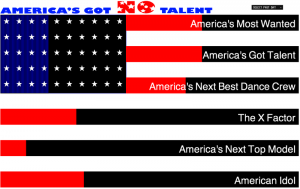The Programmed: Rules, Codes, and Choreographies in Art, 1965-2018 exhibit at The Whitney Museum explores artwork created at the intersection of technology and art. The pieces in this exhibit examine the thin line technology can play in the distribution of “traditional” art. Each piece uses technology to highlight the effect automation and computation can have on a piece of art and the artist straddles a fine line of “traditional” art and technology. Many of the pieces such as America’s Got No Talent actively critique the increased use of technology and how they affect and shape our society. America’s Got No Talent, a web-based art piece by Jonah Brucker-Cohen and Katherine Moriwaki which used the American flag as it backdrop to display and graph tweets. Each strip in the flag represents a reality TV show with the word “American” in it.

I found this piece to be the most interesting because as Moriwaki one of the creators says, “those talent shows and contest shows really play into that, this kind of deep-seated dream that––you know, you can be nobody or anybody—in the United States and find fame and fortune. And in fact, this way in which basically, social media has created stars, created celebrities, it was something that we wanted to comment on, so the piece kind of speaks to that and speaks to the echo chamber of social media.” America’s Got No Talent explores the theme of American meritocracy and the rise of fame for the purpose of fame rather than talent.
Another piece of interested would be the main show stopper piece, the centerpiece of the exhibition was Nam June Paik’s Fin de Siecle II, which a huge, newly restored, multi-channel 1989 installation. The piece has not been displayed since its original showing at a 1989 Whitney Museum exhibition which it was created for.
The piece work consists of 207 televisions, all of which are older, cathode-ray tube models from the time of the work’s creation is accompanied by a booming electronic base and a montage of images pulled from tv shows, music videos, and advertisements. Images of David Bowie, a man and woman dancing, piano keys, naked women walking against a fleshy backdrop, and a number of other images that move too fast for the brain to process. The sculpture serves s commentary on how digital content saturates our lives, and in the age of Youtube, Memes, iPhones, and Influencers, the restoration of this piece is particularly needed.
Fin de Siecle II also helps to decide the exhibit into two, the first displays pieces from artists like Josef Albers, Donald Judd, and other mid-century artists the use algorithms to create paintings, sculpture, print work, and simple projections. The second display pieces that focus on “the use of instructions and algorithms to manipulate” to create digital art pieces using television programs, sets, and signals, or image sequences and like Paik’s piece, Brucker-Cohen and Moriwaki piece many of the works serve as a critique on society.
The Programmed: Rules, Codes, and Choreographies in Art, 1965-2018 exhibit at the Whitney’s collection, looks back at predecessors of computational art and shows how the ideas addressed in those earlier works hold up and have evolved in contemporary artistic practices.